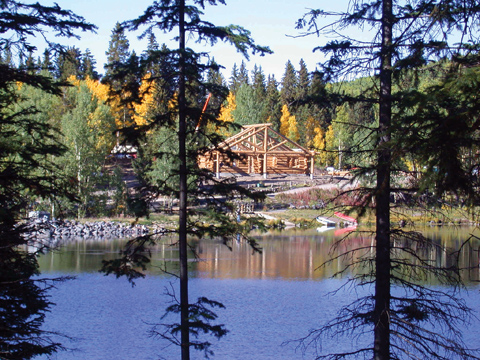Building a log home is, quite simply, an adventure. And nobody should undertake an adventure without adequate preparation.
When Jock Davidson, owner of Daniel Boone Log Homes, considers the process of building a log home, he advises, “The nature of home building, particularly log homes, is usually more art than science. No two log homes are exactly the same, and therein lies the art. The single biggest pitfall that homebuyers face is unrealistic expectations. The home will invariably take longer to build, cost more, and will probably be imperfect in some way. The homeowner needs to expect some time delays and slight cost overruns, plan accordingly, breathe deeply, and smile frequently.”
With such admonitions in mind, the log home construction process can be immensely rewarding, the fulfillment of a lifelong dream. However, understanding the process and maintaining a degree of flexibility throughout can relieve a tremendous amount of stress and uncertainty.
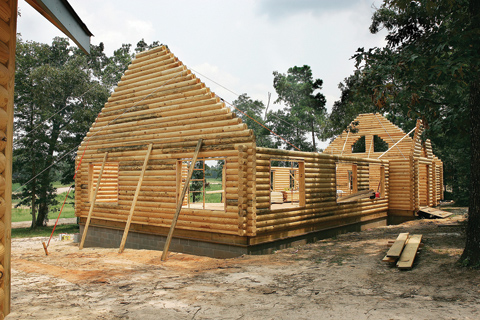
While the devil is often in the details, the basic components of log home construction are straightforward. “The major steps, simply put, are planning, contracting, and construction,” offers Greg Grimes, sales manager of Expedition Log Homes, LLC. “In a word, planning is research, doing the legwork before selecting the log home company, contractor, and lender. Planning also involves plan design, determining the budget and size of the home. Contracting focuses mostly on builder options, interviewing and then checking references of potential builders before the bidding process starts. The construction process is the culmination of all these decisions, resulting in the completion of the homeowner’s dream log home.”
Although each of these major elements includes numerous underlying aspects, the acquisition of land and the development of plans are prerequisites for the continuation of the overall project. “You can’t really do anything until you have property and plans,” notes Matthew Sterchi of StoneMill Log Homes. “The drafting of plans may actually take months depending on modifications or changes so that you can get what you want. The plans must conform to the lot with considerations for slope and required setbacks, so there may be as much time in the design phase as in the actual construction.”
Selecting a general contractor will ease the development of a realistic budget, firming up costs during consultation with the contractor and potential vendors. Homeowners come to grips with decisions relating to absolute nonnegotiables versus things that would be nice to have. A solid budget guides the remainder of the process.
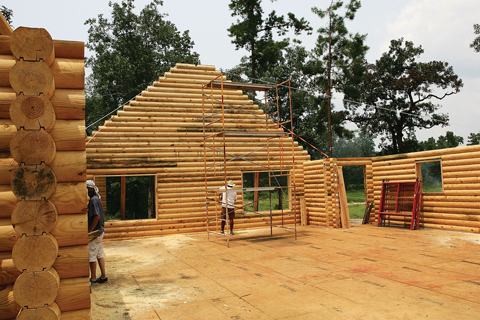
Selecting a log home manufacturer follows and involves several considerations. Decide on a certain style, handcrafted or milled, full log or insulated half-log, and the desired species of wood. Weigh the benefits of kiln drying versus air drying to reduce moisture content. Davidson advises homeowners to select two or three log home manufacturers, get quotes or estimates for their packages, and make sure that the packages are as similar as possible. Check references, talk with a company’s previous customers, refine the plans, and then settle on a date for package delivery.
If outside financing is required, prequalifying for a loan can assist in the budgeting process. Eventually, the presentation of plans, cost estimate and overall budget and personal financial information will facilitate final loan approval. Typically, potential borrowers can receive an answer to a loan request within a week, while appraisal and document preparation take four to six weeks.
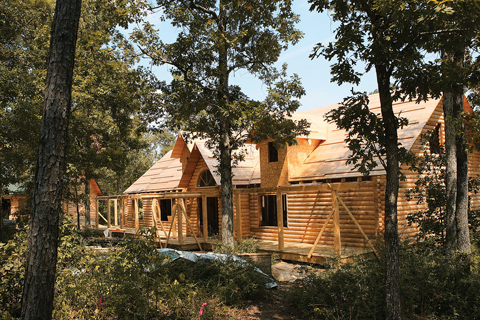
After financing is arranged, the general contractor procures the necessary permits, and site preparation begins with staking the house, followed by clearing and excavation, ordering of temporary utilities, the placement of footings, foundation installation and soil treatment, delivery of the log home package, roughing in plumbing, framing and drying in, exterior work, installation of chimney and roof systems, insulation, installation of subfloor and flooring, drywall hanging, interior trim and cabinet installation, painting, interior finishes, installation of carpet or finishing of hardwood floors, driveway preparation and finish, landscaping, and final punch list work.
Of course, several of these steps in construction may be happening concurrently. “If you have done your work on the front end and hired a general contractor, you will mainly be managing issues that may come up,” says Sterchi, “and there will be some. Recently, we heard of a construction project where everything had been picked out and the process was being managed, but the homeowner didn’t know they were going to hit rock until they started digging. The preparation of a well is another unknown. How many feet will you have to go to hit water? That can dramatically affect overall cost.”
While construction periods vary, basic log homes of 1,500 to 2,000 square feet can reach the dry-in phase in five to eight weeks, while the finishing of the home may require an additional three or four months. Weather conditions and the changing seasons may affect the construction schedule, particularly early in the process.
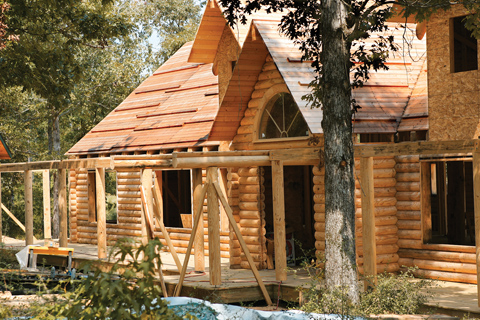
“Size, complexity, and the experience of the builder will impact the typical timeframe of log home construction,” comments Grimes. “I have seen log homes constructed in less than three months or as long as two years or more. Typically, our log homes are completed within six to eight months. From ground breaking to moving in, each change along the way seems significant. The first delivery of log home materials is an exciting event, watching 18-wheelers roll onto the property. The weather-tight shell construction goes quickly, often completed within two months of ground breaking. Finish construction seems to take the longest, but should not be rushed.”
In recent years, notes Grimes, products such as Superior Walls have streamlined the foundation process, expediting the overall construction timeframe. More options for preassembled roof trusses have also reduced the construction period. Prenotched, prefitted, and prenumbered log corners have accelerated construction and saved money as well.
Within a reasonable period of time, well-informed and prepared homeowners can easily find themselves experiencing the most important aspect of the construction process: moving in and enjoying the experience of log home living.

